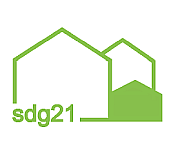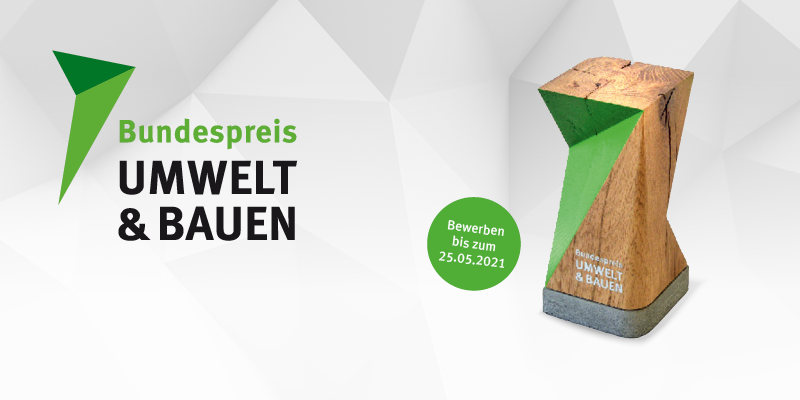You may also like
 The Federal Award ENVIRONMENT & BUILDING initiated by the Federal Ministry for the Environment, Nature Conservation and Nuclear Safety (BMU) and the Federal Environment Agency (UBA) under the patronage of Federal Minister Svenja Schulze honors projects that already realize the idea of a new Bauhaus in the sense of holistically sustainable buildings. In 2021, the prize will be awarded for the second time, this time in four categories. All players in the building sector are eligible to apply. The closing date for entries is 25 May 2021.. The prize will be awarded on 7 September by Parliamentary State Secretary Florian Pronold and UBA President Dirk Messner.
The Federal Award ENVIRONMENT & BUILDING initiated by the Federal Ministry for the Environment, Nature Conservation and Nuclear Safety (BMU) and the Federal Environment Agency (UBA) under the patronage of Federal Minister Svenja Schulze honors projects that already realize the idea of a new Bauhaus in the sense of holistically sustainable buildings. In 2021, the prize will be awarded for the second time, this time in four categories. All players in the building sector are eligible to apply. The closing date for entries is 25 May 2021.. The prize will be awarded on 7 September by Parliamentary State Secretary Florian Pronold and UBA President Dirk Messner.
The discussion about the climate, environmental and health impacts of buildings and their construction has long since reached the centre of society. Topics such as primary energy demand, grey energy or healthy building are no longer just the preserve of experts, but are also attracting the attention of more and more private and public building owners. And rightly so - because the building sector consumes enormous raw material and energy resources, and building products can be harmful to the environment and health. Sustainable solutions already exist today and are already being implemented. The Federal ENVIRONMENT & BUILDING Award therefore honours lighthouse projects in the field of sustainable building and helps to bring the EU Commission's vision of a "New European Bauhaus" to life.
About the Federal Award
This year, the Federal Award will again be presented in the categories "Residential Buildings", "Non-residential Buildings" and "Neighbourhoods". A fourth category, "Climate-friendly refurbishment", is new. In addition to these competition categories, the jury may award special prizes for particularly innovative approaches among the projects submitted.
Conditions of participation
Due to the thematic breadth, all actors in the building sector are invited to apply: from builders and developers to offices for architecture, building services engineering, urban or landscape planning to manufacturers or research institutions. The call for entries is aimed at buildings that have already been completed in Germany or neighbourhoods that are at an advanced stage of planning; multiple applications in different categories are possible (also applies to refurbishment projects!).
What awaits the winners
The award winners will receive public attention on several levels. The award ceremony will take place on 7 September 2021 at the Federal Ministry for the Environment, Nature Conservation and Nuclear Safety in Berlin, where the award-winning projects will be presented to experts and the media. The award-winning projects will also be featured on the websites of UBA and the Federal Environment Ministry. UBA is having films made on the award-winning sustainability examples, which the winners can then use for their own public relations work. Furthermore, all award-winning projects will be documented in a book.
Further
For more information on the conditions of participation in the Federal Environment & Building Award and last year's winners, please visit the Federal Award website: www.umweltbundesamt.de/bundespreis-umwelt-bauen.
Application deadline: 25 May 2021
Source: BMU
Keywords:
Contests & Prizes
Almost 1 billion euros in federal funding for urban development and social integration in neighbourhoods in 2020
The federal and state governments have jointly developed a new structure for urban development funding from 2020: A total of €790 million will be available in three (instead of the previous six) concentrated urban development funding programmes. In addition to the funding requirement of climate change/climate adaptation, including urban greening, the possibility of stronger inter-municipal cooperation has also been added.
A further 200 million euros are available in the "Social Integration in the Neighbourhood" investment pact. This will enable the municipalities to press ahead with the expansion and refurbishment of their social infrastructure.
Federal Minister of the Interior Seehofer signed the corresponding administrative agreements today. Federal funding for urban development and social integration will thus be stabilised at a high level.
Federal Minister of the Interior Seehofer: "We are streamlining our funding structure. This will make it easier for cities and municipalities to implement their projects. In addition, climate protection will become a funding requirement. Urban development funding without climate protection will no longer exist in the future."
The following federal-state urban development programs are available for the 2020 funding year:
- "Living Centres" to promote inner development and historic city centres (300 million euros),
- "Social cohesion" to promote coexistence in neighbourhoods (EUR 200 million),
- "Growth and Sustainable Renewal" to adapt to demographic and structural change and to design liveable neighbourhoods (290 million euros),
- "Investment Pact for Social Integration in the Neighbourhood" (200 million euros).
The administrative agreements will enter into force as soon as all federal states have countersigned.
The urban development funding provided by the federal and state governments triggers considerable follow-up investments. For the year 2020, it is assumed that the total investment volume triggered by the funding will be around 12 billion euros, and the expected gross value added will be around 14 billion euros. The subsidies also support the small and medium-sized local economy to a large extent: approx. 36 percent of the expected construction volume remains in the municipality itself, another approx. 48 percent in the region with a radius of 50 km. The construction industry benefits from this with 71 percent of the implemented investment funds.
Source: PM of the Federal Ministry of the Interior, for building and homeland (BMI) from 19.12.2019
Keywords:
DE-News, Funding, Quarters, Settlements, Housing policy
 Since February 2017, the houses of Chiemgauer Holzhaus have been awarded the RAL quality mark GZ 425. The solid wood houses achieve a GWP (Global Warming Potential) value of less than zero in their carbon footprint. This was tested by the "Gütegemeinschaft CO2 neutrale Bauwerke in Holz e.V.".
Since February 2017, the houses of Chiemgauer Holzhaus have been awarded the RAL quality mark GZ 425. The solid wood houses achieve a GWP (Global Warming Potential) value of less than zero in their carbon footprint. This was tested by the "Gütegemeinschaft CO2 neutrale Bauwerke in Holz e.V.".
Taking into account all the necessary materials, such as concrete foundation, roof tiles, glass windows, etc., this means in the case of a solid wood house with approx. 150 m² of living space an CO2 reduction capacity of approx. 23,000 kg!
By comparison, a conventionally built house with bricks and otherwise the same conditions pollutes the environment with 24,000 kg of CO2. (Source: www.chiemgauer-holzhaus.de/
Certification of CO2 neutral solid wood buildings
Every building generates a verifiable "Global Warming Potential" (GWP) during the production of the building materials and during construction, which is primarily caused by the energy consumption during production. The aim of the new quality association is to certify solid timber buildings whose manufacturing energy balance has a GWP value of less than zero. This means that a manufactured solid wood building is at least CO2 neutral, or even has a CO2-reducing effect. For this purpose, the "German Institute for Quality Assurance and Labelling" (RAL) approved the "Quality Mark CO2 Reducing Wooden Structures" in 2015, which is awarded by the "Quality Association CO2 Neutral Structures in Wood". The quality mark has a modular structure and currently includes Part A of the EPDs as a component and basis. As soon as further European-recognised and standardised product indicators are available up to the disposal of a material, the quality mark will be extended with the same criteria in order to ensure a holistic view.
The basis of the "Quality mark for CO2-reducing timber structures" is timber from sustainable forestry. The more wood is used in construction and the more trees are replanted accordingly, the greater the CO2 reduction in our climate, both in the short and long term. The prerequisite for the award of the quality mark is the calculation and documentation of the EPDs as well as external monitoring according to the strict criteria of RAL.
INFOS:
Quality Association for CO2-neutral Buildings in Wood e.V., Munich
Internet: www.wood-co2.eu
RAL Guideline (June 2015): www.wood-co2.eu/file/co2-senkende-holzbauwerke-guetesicherung-ral-gz-425_cf941.pdf
Keywords:
DE-News, Wood construction, Climate protection, Certification & Labels, Life cycle assessment
Min. 8:16; Video from 7.1.2020; Ed.: MWSP Mannheim
Keywords:
Stock, Barracks conversion, News Blog Baden-Württemberg, Quarters


